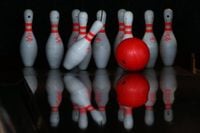In a groundbreaking development for the world of ten-pin bowling, a multinational team of scientists has unlocked the secret to scoring the perfect strike. By leveraging complex differential equations, initially devised by the 18th-century polymath Leonhard Euler, researchers have created a predictive model that could revolutionize competitive bowling. This innovative project, which involved physicists and engineers from Loughborough University and several American universities, was detailed in the journal AIP Advances.
The researchers ran simulations that accounted for a variety of factors, including spin, friction, and the crucial oil patterns applied to the lanes. These simulations were based on the bowling style of a hypothetical average bowler, who releases the ball at an impressive speed of 17.9 mph, at a 45-degree angle, and with a spin rate of 416 revolutions per minute (rpm). Simon Ji, a researcher from Princeton University, emphasized the complexity of bowling ball movement, stating, "Bowling ball movement is surprisingly challenging to model," and noted the significant variability in friction conditions and ball weights across different alleys.
One of the key findings of this study was the impact of oil patterns on the likelihood of achieving a strike. The researchers meticulously examined the conditions of oil patterns used in current bowling tournaments, revealing that the oil is applied to the lanes in specific patterns designed to create challenging friction profiles. Their simulations indicated that the optimal strategy for scoring a strike is to release the ball from the 28th board from the left, angling it 1.8 degrees to the right of a straight line. This approach allows the ball to follow a curved path—the most effective route for scoring a strike—while also accommodating a substantial margin of error. As they noted, "In real life, no bowler can hit their target with 100% accuracy."
What makes this model particularly exciting is its potential application for various bowlers under different conditions. The authors of the study hope their research will be practically implemented in the competitive bowling scene, which has seen a resurgence in popularity in the UK. With tenpin lanes reaching a record 5,700 and Hollywood Bowl reporting unprecedented sales of £230 million last year, the sport is clearly on the rise.
Dr. Curtis Hooper from Loughborough University remarked, "The simulation model we created could become a useful tool for players, coaches, equipment companies, and tournament designers." Meanwhile, Ji added, "We are already in contact with several well-known coaches in the field, and hope to tailor our simulations to better fit their needs in the near future." This collaboration could lead to further refinements of the model, ensuring it meets the specific demands of competitive bowling.
Physics is indeed making waves in bowling alleys with this unprecedented predictive model. By incorporating physical parameters such as variations in oil application on the lanes and friction, the researchers have developed a tool capable of calculating the ideal trajectory to achieve a strike. This model represents a significant leap beyond traditional approaches by utilizing six differential equations to simulate trajectories with unmatched precision.
As players now have the opportunity to rely on scientific assistance to enhance their game, the implications of these findings are profound. The oil applied to the lanes varies in quantity and distribution, creating unique conditions for each game. The model adeptly accounts for these variations, suggesting tailored strategies for bowlers. Furthermore, it includes an error margin to compensate for human inaccuracies, making it a practical resource for players of all skill levels.
At the core of this innovative model are Euler's equations for rotating rigid bodies, which predict how the bowling ball will react based on its rotation and initial trajectory. This scientific foundation provides a solid basis for reliable predictions that can help bowlers optimize their performance.
The researchers have also made strides in simplifying complex concepts to make the tool accessible to players and coaches without requiring a deep understanding of physics. This user-friendly approach paves the way for new strategies and equipment optimization, providing ball manufacturers with inspiration to design higher-performance products tailored to real game conditions.
Improvements to the model are already being considered, including the integration of lane irregularities, which could further enhance its accuracy. By collaborating with professionals in the field, the researchers aim to refine the model to better suit the specific needs of competitive bowling.
Understanding the influence of lane oil on the ball's trajectory is crucial for any bowler. The oil applied to the lanes alters the friction between the ball and the wood, and this often uneven layer can significantly change the ball's path. With the introduction of this model, players can visualize these variations and anticipate their impact, offering them an unprecedented advantage in their performance.
This development not only benefits players but also opens up new perspectives for lane designers. They can use this information to create fairer or more challenging playing conditions, depending on the objectives of the tournament or event.
As the world of bowling continues to evolve, the integration of physics and technology offers exciting possibilities for both players and fans. With the potential for enhanced strategies and improved equipment, the future of competitive bowling looks bright, and these groundbreaking findings are sure to play a significant role in shaping that future.






